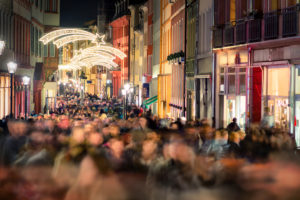
Christmas time, and the lead up to it, can be a challenging time to navigate. From the stress of shopping – thinking about what gifts to buy and then actually going out and purchasing them, to preparing for family gatherings and then actually enjoying this time of year.
Whether you celebrate Christmas or not, we all have to navigate the craziness, in shopping centers, supermarkets, in the city and on the roads.
Introverts naturally don’t like crowds, but even extroverts who thrive on groups can get to the point where they’ve had enough of the craziness at this time of year.
For me, growing up as a sensitive introvert, I never liked all the people around. There were just too many. At the same time a part of me really enjoyed the sense of connection that was more present at this time of year but reconciling the two inside myself was a struggle.
Later in life, as I came to understand myself more deeply, I discovered a greater stability inside myself. I call this stillness. I still have a preference for quiet and less crowded places and situation, but with the stability of stillness I can be in seemingly chaotic events or gatherings without it affecting me.
An important lesson I learned was the difference between being aware of the craziness around me and being affected by it.
Separating from the craziness
Label it
A simple practice you can use anytime you’re overwhelmed, stressed or anxious is to label how you’re feeling. Ask yourself:
What am I feeling?
What emotion am I experiencing?
As you label it take a moment to actually feel it. You’re not just thinking about it, you’re feeling it.
An important part of this is noticing how you feel different when you label the emotion and when you can observe it. Does the intensity of the emotion become less, or perhaps even disappeared? Do you feel like you have more freedom? Do you feel clearer?
Labelling how you feel will help you create a sense of space between you and the stress. When you’re in the stress or overwhelm there’s not much you can do about it, but the moment you start to consciously feel and label your emotional state, you gain the ability to be mindful and conscious as opposed to being a victim to you’re motions.
If you’re stressed and your shoulders are up around your ears they may stay there, but the moment you consciously notice it you have the capacity to simply let it go. The same principle is true for your emotions, recognizing it will give you the opportunity to let it go.
Remember you’re doing this for a reason… you want to shift your state of mind from stress and overwhelm to calm clarity.
If you try this and find that you can’t label your emotion, notice if there is a part of you that does not want to admit what you’re feeling. If you identify this, then see if you can label your emotion.
You and the world around you
Once you recognize what you’re experiencing inside yourself, you can then start to pay attention to what’s happening around you. This contrast helps you to realize what is you and what is not you.
An important distinction to realize within your own experience is that there is being aware of the craziness around you and then there is reacting to it. Observing it gives you space and power, reacting to it consumes you and leaves you powerless.
Below is a exercise I often share with people to help them find a sense of calm while being is a chaotic atmosphere.
Finding Stillness Amidst the Chaos
- Find a crowded place, preferably where there’s a lot of noise. A busy food court at lunch time is a good one. Perhaps before a conference or event when everyone around you is talking. The more people the better. During Christmas time craziness this will not be a problem.
- Remain quiet and start listening peripherally to all the people talking. Don’t listen to individual conversations or voices. Listen to them all at once. The peripheral noise.
- If thoughts enter your mind, just let them go and return to the peripheral noise. Don’t judge your thoughts.
- After listening to the peripheral noise for a while, start to notice there is the chaos of the noise all around you, but you are not the noise. There is a separation between you and the noise. It’s like you are in the eye of a tornado and the noise is the tornado. Notice the stillness in the center. It’s the place where you observe the noise from.
- The key here is the noise and chaos in the periphery and stillness in the center. Thoughts will come and go but keep your awareness with the peripheral noise and center.
- This may take some time to get the hang of it, but like anything else with practice you will see progress. You may even find this fun.
- This may take some time to get the hang of it, but like anything else with practice you will see progress. You may even find this fun.
Meditation
Meditation is one of the most effective practices to help you find stillness inside of yourself. The more you train yourself to know the stillness the more it will be available to you when you really need it.
…



